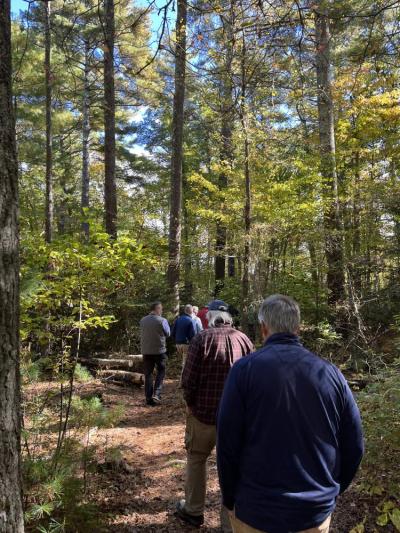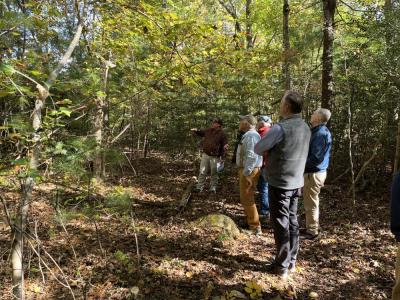‘It may be time’: Forester recommends intervention for town-owned woods property
MARION — A 1950 Standard-Times article described a tract of land tucked between Route 6 and Spring Street as “originally a beautiful site of pines.”
Townspeople held cookouts and enjoyed nature in this forested area called Holmes Woods. A hurricane in 1938 completely destroyed the woods. A hurricane in 1944 also wrecked the wooded area.
In the following years, efforts were undertaken to salvage Holmes Woods and re-establish it as a forest.
Today, the property is overstocked — there are too many trees growing in the woods, according to Tom Farrell, a forester tasked by Marion to assess Holmes Woods. He recommended to the Marion Select Board in March that smaller trees be removed to allow for better spacing and spread of resources.
That idea was again expressed as Farrell guided Marion officials through the property Tuesday, Oct. 15.
During a walk through the town-owned land with the Marion Select Board and other community members, Farrell said “it may be time to start to think about cleaning out” the trees that have “lost the race and focus on the ones that are clearly thriving and look really, really good.”
“You have some pockets of old disturbed areas that now have young trees growing, and you want to think about selecting the trees that are really loving life and keep them going,” Farrell said.
The more diversity of species in a forest, the better, according to Farrell.
Diversity helps to better weather diseases, pests and storms. Holmes Woods has a diverse set of tree species but doesn’t have a density of them, Farrell said.
“You have this really good opportunity to get in there and start to focus on some of the hickories, some of the maples, some of the hollies, so that in 30, 50 years, you look up in the canopy, it has a bunch of different trees as opposed to just one or two species,” he said.
Many of the trees inside Holmes Woods are growing too close together, competing with resources with one another, according to Holmes. That, in essence, stresses the trees out. Like stress in humans can weaken the immune system, stressors make trees more susceptible too, Farrell said.
Walking through the wooded area’s trails, Farrell’s recommendation to town officials was to “come in and be a little proactive” in selecting the better formed, more vigorous trees as “the winners.”
That will allow those trees to have more resources and less stress.
After the hurricanes in the 1930s and 1940s, whatever grew in Holmes Woods was just allowed to grow. A lack of intervention usually leads to less diversity and density, according to Farrell.
“Increasing diversity of tree species and diversity of age classes within the tree species, that’s huge,” he said. “That usually provides you with a forest where you can say, ‘Hey, whatever Mother Nature throws at it, we have a chance.’”
















